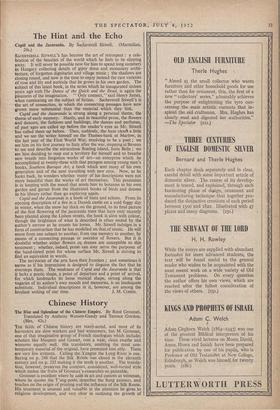The Hint and the Echo
SACHEVERELL SITWELL'S has become the art of retrospect : a cele- bration of the beauties of the world which he feels to be slipping away. It will never be possible now for him to spend long summers in Hungary collecting details of gipsy dress and monastery archi- tecture, of forgotten dignitaries and village music ; the shadows are closing round, and now is the time to enjoy instead the rare varieties of rose and lily and auridula that he grows in his own garden. The subject of this latest book, in the series which he inaugurated sixteen years ago with The Dance of the Quick and the Dead, is again the pleasures of the imagination. " Only connect," said Henry James, when ruminating on the subject of fiction. Sacheverell Sitwell's is the art of connection, in which the connecting passages have now grown more substantial than the material which they link. Cupid and the Jacaranda is strung along a personal theme, the theme of early memory. Hazily, and in beautiful prose, the flowers and dancers, the fashions and buildings, the dances and perfumes, of past ages are called up before the reader's eyes as Mr. Sitwell has called them up before. Then, suddenly, the haze cleat a little and we see the writer himself on the Thames-bank at Marlow, in the last year of the First World War, resolving to be a poet ; we see him on his first journey to Italy after the war, stopping at Baveno to see and describe the miraculous floating island, Isola Bella ; we see him deciding to map out a territory for himself and to breathe new breath into forgotten works of art—an enterprise which he accomplished at twenty-three with that paragon among young men's books, Southern Baroque Art, a book which sent many of his own generation and of the next travelling with new eyes. Now, as he looks back, he wonders whether many of hie descriptions were not more beautiful than the works of art themselves. This pessimism is in keeping with the mood that sends him to botanise in his own garden and garner from the illustrated books of birds and dresses in his library rather than go exploring again. Cupid and the Jacaranda is a book of hints and echoes. From its opening description of a fire in a Danish castle on a cold foggy day in winter, when the snow lay thick on the ground, to its final picture of the first flowering of the jacaranda trees that have only recently been planted along the Lisbon streets, the book is alive with colour, though the brightness of what is described is often muted by the author's sorrow as he counts his losses. Mr. Sitwell indulges in a form of construction that he has modelled on that of music. He will move from one subject to another, from one memory to another, by means of a connecting passage or corridor of flowers. But it is doubtful whether either flowers or dresses are susceptible to this treatment ; whether, indeed, prose can ever serve the purposes of the hand-tinted print for whose surface Mr. Sitwell is striving to find an equivalent in words. The territories of the arts have their frontiers ; and sometimes it seems as if his imprecision is designed to disguise the fact that he. oversteps them. The weakness of Cupid and the Jacaranda is that it lacks a poetic shape, a point of departure and a point of arrival, for which landmarks its loose musical shape, strung along the vagaries of its author's own moods and memories, is an inadequate substitute. Individual descriptions in it, however, are among the


























































 Previous page
Previous page